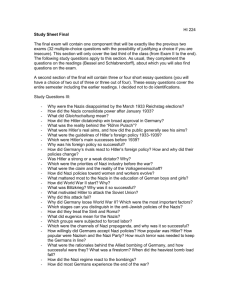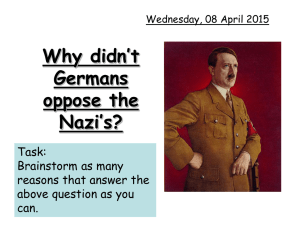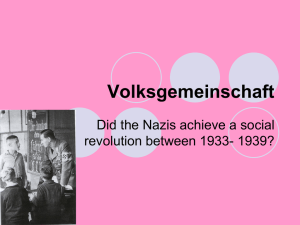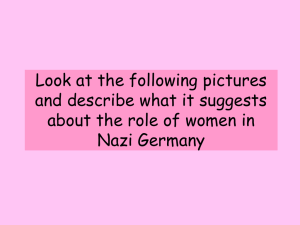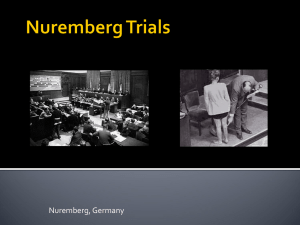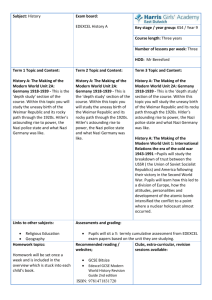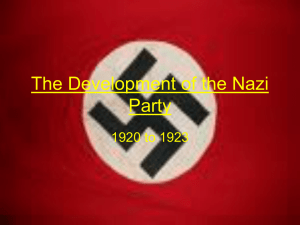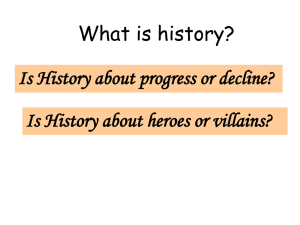Volume 17, Number 4, April 2015 Exam focus AQA: Life in Nazi
advertisement
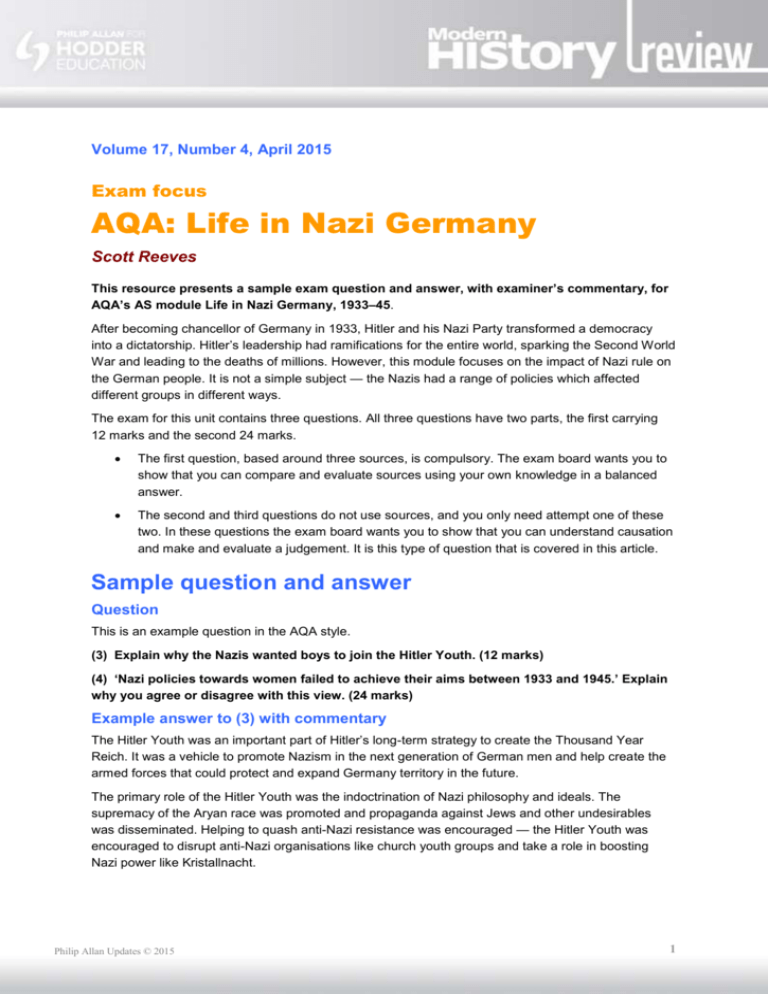
Volume 17, Number 4, April 2015 Exam focus AQA: Life in Nazi Germany Scott Reeves This resource presents a sample exam question and answer, with examiner’s commentary, for AQA’s AS module Life in Nazi Germany, 1933–45. After becoming chancellor of Germany in 1933, Hitler and his Nazi Party transformed a democracy into a dictatorship. Hitler’s leadership had ramifications for the entire world, sparking the Second World War and leading to the deaths of millions. However, this module focuses on the impact of Nazi rule on the German people. It is not a simple subject — the Nazis had a range of policies which affected different groups in different ways. The exam for this unit contains three questions. All three questions have two parts, the first carrying 12 marks and the second 24 marks. The first question, based around three sources, is compulsory. The exam board wants you to show that you can compare and evaluate sources using your own knowledge in a balanced answer. The second and third questions do not use sources, and you only need attempt one of these two. In these questions the exam board wants you to show that you can understand causation and make and evaluate a judgement. It is this type of question that is covered in this article. Sample question and answer Question This is an example question in the AQA style. (3) Explain why the Nazis wanted boys to join the Hitler Youth. (12 marks) (4) ‘Nazi policies towards women failed to achieve their aims between 1933 and 1945.’ Explain why you agree or disagree with this view. (24 marks) Example answer to (3) with commentary The Hitler Youth was an important part of Hitler’s long-term strategy to create the Thousand Year Reich. It was a vehicle to promote Nazism in the next generation of German men and help create the armed forces that could protect and expand Germany territory in the future. The primary role of the Hitler Youth was the indoctrination of Nazi philosophy and ideals. The supremacy of the Aryan race was promoted and propaganda against Jews and other undesirables was disseminated. Helping to quash anti-Nazi resistance was encouraged — the Hitler Youth was encouraged to disrupt anti-Nazi organisations like church youth groups and take a role in boosting Nazi power like Kristallnacht. Philip Allan Updates © 2015 1 The Hitler Youth was also designed to prepare German boys for armed service, aiming to create a strong military force in the future. Boys were put through physical fitness and training courses, as well as learning how to operate weaponry, map reading and basic tactical awareness. Conditions were often austere and discipline was strict in order to prepare boys for military life. From 1939, the function of the Hitler Youth shifted from creating long-term stability in the Nazi regime to helping ensure its short-term survival. In wartime, the Hitler Youth took on a more direct military role, assisting the fire services and anti-aircraft crews to protect cities from bombing. As the war progressed, younger and younger members of the youth were drafted in to military regiments and tasked with fighting, with members as young as twelve being asked to fight in the final months. The answer to this question provides three reasons why boys were encouraged to join the Hitler Youth: it was a form of indoctrination in Nazi ideas, it helped prepare them for military life in the future, and it helped defend Germany in the Second World War. It also organises the factors, suggesting that there were both long-term and short-term reasons, and that the relative importance of those reasons changed after 1939. Since this answer successfully links and organises the reasons, it would receive the highest level of response and 12 marks. Example answer to (4) with commentary The Nazis had very strong views about the place of women in society. Women were not considered to be equal, a reversal of growing female equality which happened under the Weimar Republic. Instead, it was a woman’s duty to remain at home as a child-bearer and to support her husband — the idea of Kinder, Küche, Kirche. Most importantly, the Nazi regime encouraged a high birth rate because it would help Germany to grow in strength and expand beyond her borders into the Lebensraum. In order to increase the birth rate, Hitler sought to prevent women from working outside of a few specialised positions. Opportunities for women declined between 1933 and 1937. In 1933, 37% of workers were female. Within months of Hitler coming to power, many female doctors, civil servants, teachers and lawyers were sacked. By 1935, the number of female secondary school teachers had declined by 15%. Putting up barriers and making it difficult for women to find employment was one way of increasing the birth rate and achieving Nazi aims. The other was to introduce rewards to encourage child-bearing. The Law for the Encouragement of Marriage stated that all newly married couples could receive a government loan of 1000 Reichsmarks. The birth of one child meant that 25% of the loan was written off. A second, third and fourth child wrote off subsequent quarters until the entire loan was cleared. In addition, the Cross of Honour of the German Mother was awarded to women who had given birth to a large number of children. A bronze cross was given to women who had four children, a silver cross for six children and a gold cross for eight children. This military-style reward boosted the feeling that women were able to contribute to the Nazi regime and Germany. Nazi policies encouraging women to leave employment and raise children were supported by propaganda and indoctrination techniques which reinforced expectations. The National Socialist Women’s League was responsible for delivering propaganda. Women were not expected to wear make-up, high heels or trousers. They were not expected to dye their hair or style it in a perm. They were discouraged from being too slim as it was thought to be detrimental to childbirth. In addition, the education system indoctrinated girls from a young age. The German Girls’ League promoted male superiority and the importance of child-bearing. As a result of the propaganda and other policies Philip Allan Updates © 2015 2 towards women, the birth rate rose from 14 per thousand in 1933 to 20 per thousand in 1939, indicating that the Nazis were successful in achieving their aims. However, many women objected to their reduced status and joined political groups to voice their opposition. In October 1933, the first concentration camp for women opened in Moringen. By 1938 it was over-capacity and two more camps were constructed. This suggests that Nazi policies towards women were not successful across the whole of society — a minority of opposition remained. The Nazi regime was also less successful in fulfilling its aims for women in later years. As a shortage of workers developed, especially during wartime, women were allowed to work in certain industries. Such was the shortage by 1937 that a law was passed which declared that women had to do a Duty Year. They were told to help economic growth by working in a factory or similar occupation. The Law for the Encouragement of Marriage was also abolished, indicating that having children was becoming less of a priority for the Nazi government. The long-term aim of increasing the birth rate to create a stronger Germany in the future was sacrificed to get women working in factories to increase the strength of Germany in the short term. Nazi policies towards women were successful in the first years of the Nazi regime, increasing the birth rate and reducing the number of women in work. However, it is important to recognise that some opposition remained. As the Nazi dictatorship progressed, its success in achieving its aims for women gradually diminished, pressured by preparations for war and war itself. This answer hits all the key areas an examiner looks for. It would receive 22 marks out of 24. One of the first things an examiner wants to see is whether an answer considers both sides of the question. This one does. Paragraphs 2 to 5 consider how the Nazis tried to achieve their aims by increasing the birth rate. Paragraphs 6 and 7 look at the ways in which the Nazis were unsuccessful. The answer is also consistently analytical. It doesn’t just describe Nazi policies towards women, it attempts to explain them and say how and why they affected the birth rate. It includes a judgement at the end, which is vital in gaining the highest marks. The line of argument in this answer is that the Nazis were successful in achieving their aims at the start of their time in power, but were less successful towards the end. This line of argument is rewarded highly, but you might have an alternative view — don’t be afraid to express it! To help get the extra 2 marks that are missing, it would be good for the judgement to be made at the beginning of the essay in an introduction. At the moment, the introduction just defines what Nazi aims were for women’s policies. Overall assessment The total mark for this answer is 34 marks out of 36, which would easily achieve a grade A. Look at the techniques that this student used to get such a high mark, and try to use them in your own work! Scott Reeves is a former head of history and A-Level examiner. This resource is part of MODERN HISTORY REVIEW , a magazine written for A-level students by subject experts. To subscribe to the full magazine go to: http://www.hoddereducation.co.uk/historyreview Philip Allan Updates © 2015 3
